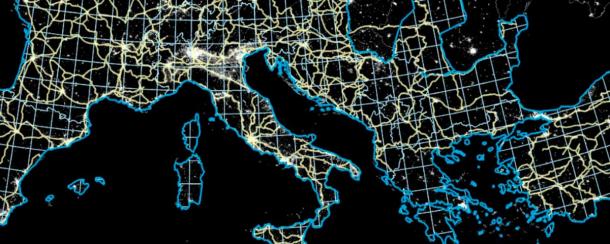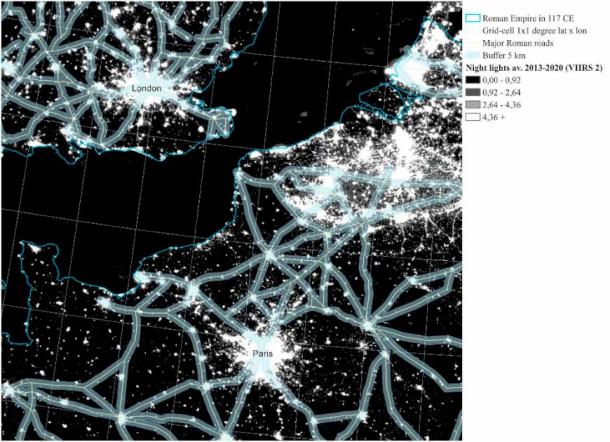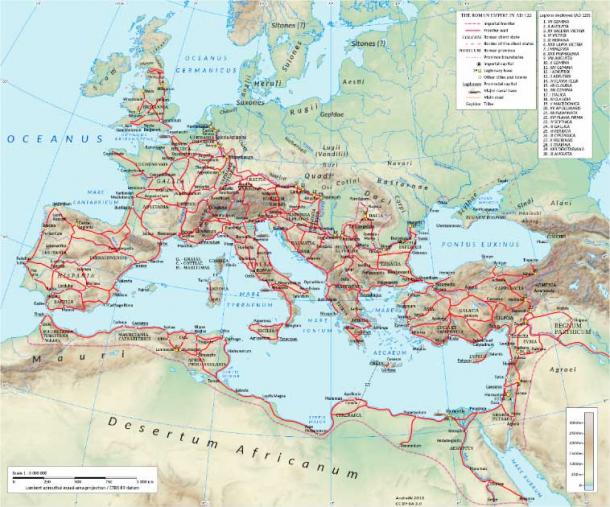[ad_1]
Some 2,000 years after the Romans established their extensive road network, regions lying along it remain the most affluent, a recent study has found. The Roman road network links contributed to improved economic welfare in ancient times, and the prosperity imparted by them has been remarkably long-lasting, continuing into modern times.
Military Roads Doubled as Routes for Economic Activity
While the link between economic well-being and road routes may be intuitive, a study published in the Journal of Comparative Economics argues that the original purpose of the Roman road network was not economic, but military.
At its high point, the Roman road network amounted to a whopping 49,710 miles (80,000 kilometers) of road, according to a report on the University of Gothenburg website . These roads were meant to facilitate transportation of troops and military supplies to different parts of the empire, with the first of them built in 312 BC, Science Alert reported. The Roman road network didn’t build on existing roads, or take account of villages and communities along them. However, the roads soon began to be used for trade and transport, and with market towns emerging along their length, contributed significantly to economic growth.

“It is striking that our main result is that the Roman roads have contributed to the concentration of cities and economic activity along them, even though they are gone and covered by new roads”, says Ola Olsson, professor of economics at the School of Business, Economics and Law at the University of Gothenburg, and one of the authors of the study. ( Dalgaard et al. )
Which Came First: Economic Activity or Roman Road Network?
An important question the researchers had to contend with in the study was cause and effect: Did the Roman road network encourage economic growth, or did the Romans build roads in regions of pre-existing economic activity?
According to Ola Olsson, a co-author of the study and professor of economics at the School of Business, Economics and Law at the University of Gothenburg in Sweden, “That is the big challenge in this entire field of research. What makes this study extra interesting is that the roads themselves have disappeared and that the chaos in Western Europe after the fall of the Roman Empire would have been an opportunity to reorient the economic structures. Despite that, the urban pattern remained.”

To carry out the study, the researchers superimposed maps of the Roman Empire’s road network on top of modern satellite images showing the light intensity at night – one way of approximating economic activity in a geographical area. ( Dalgaard et al. )
Roman Road Network Prosperity Persists into Modern Times
For the study, the researchers superimposed maps of the ancient Roman road network over modern satellite images showing night-time light intensity, which they used as a marker of economic activity in a geographical area. The map was divided into smaller grids measuring a single degree of longitude by a single degree of latitude for closer analysis. In each box, the presence of Roman roads was juxtaposed with current infrastructure, population density, and economic activity.
The results were quite extraordinary. “Given that much has happened since, much should have been adapted to modern circumstances. But it is striking that our main result is that the Roman roads have contributed to the concentration of cities and economic activity along them, even though they are gone and covered by new roads,” said Olsson, according to Science Alert.
Results Not Uniform
However, this pattern was not uniform for the entire length and breadth of the Roman Empire. The correlation between the Roman road network and lasting economic well-being was true only in parts of the old Roman Empire territory. In the eastern parts of the empire, in North Africa and the Middle East, where wheeled transport was largely replaced by camel caravans between the fourth and sixth centuries AD, there is no marked continuity of economic prosperity. There, the Roman road network was mostly abandoned and allowed to fall into disrepair. New roads were not built on top of them, unlike in the western parts of the empire.

The Roman Empire in the time of Hadrian (ruled 117–138 AD), showing the network of main Roman roads (DS28 / CC BY SA 4.0 )
“The roads became irrelevant and thus we don’t see the same continuity in prosperity at all. It can be said that the area was affected by what is called a ‘reversal of fortune’ – countries that early on developed civilization, such as Iraq, Iran and Turkey, are today autocratic and have significantly worse economic development than countries that were then in the economic periphery”, Ola Olsson was quoted as saying in the report on the University of Gothenburg website.
Showing how very long-lasting the impact of investments in infrastructure can be, the study has an important bearing on modern-day decision-making as well. As Olsson stated, “In Sweden, for example, we are talking about possibly building new railroad trunk lines. The former, from the 19th century, gained enormous importance for economic activity in Sweden. New stretches for the railroad are discussed, and if they are built you can expect some communities to get a big economic boost.”
Top image: The extensive Roman road network has contributed to 2,000 years of economic prosperity for cities and towns that maintained them, according to a recent study. Source: Sean Gladwell / Adobe Stock
By Sahir Pandey
[ad_2]
Source link
